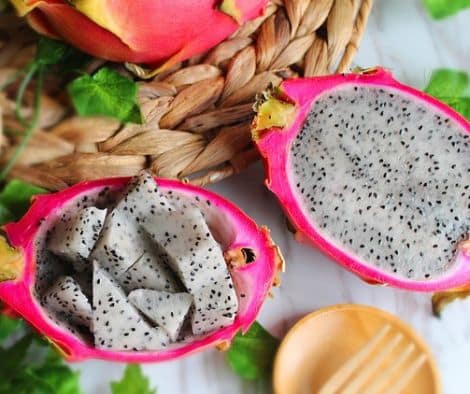Costa Rica’s dragon fruit—known locally as pitaya—touches everything travellers and residents love about the country. You can chase adventures on backroads to sunlit trellis farms, feel the pulse of culture at feria markets, sip magenta mixers in beach-town entertainment, spot bat pollinators and night-bloom blooms in biodiverse wildlife corridors, explore small-farm real estate dreams, test export-friendly business ideas, and of course feast on photogenic food that tastes as bright as it looks.

What is dragon fruit (pitaya)?
Dragon fruit is the lightly sweet, cactus-grown fruit of Hylocereus vines, celebrated for vivid skins and speckled flesh.
- Growth habit: Climbing cactus trained on sturdy posts and wires, producing spectacular night-blooming flowers before fruit sets.
- Varieties you’ll see: White- and red-fleshed pitaya are common across the Pacific and Central Valley; the yellow type (often sweeter) appears in specialist stalls.
- Flavour profile: Clean, refreshing notes—think kiwi meets pear—with tiny edible seeds that add a gentle crunch.
When is pitaya in season in Costa Rica?
Peak availability runs from late rainy season into early dry season, with warm lowlands offering extended harvests.
- Best window (guide): August to January in many zones, with shoulder crops outside these months where irrigation and heat align.
- Regional nuance: Guanacaste and other Pacific lowlands often fruit earlier and longer thanks to heat units and well-drained soils.
Where can you find dragon fruit?
You’ll find pitaya in weekly farmer’s markets, roadside stalls and on farm tours that welcome visitors.
- City ferias: San José, Heredia, and Alajuela markets usually carry multiple varieties, often sold chilled and ready to taste.
- Coastal routes: Nicoya and Guanacaste stalls on main roads display luminous stacks—perfect for beach snacks or sunset cocktails.
- Eco-lodges & cafés: Caribbean and Southern Zone kitchens fold pitaya into bowls, sorbets, and breakfast batidos.
How does pitaya fit into Costa Rican culture?
Pitaya is a feria favourite that colours home cooking, fiestas, and weekend gatherings.
- Market rituals: Families choose fruit for Sunday almuerzos, often pairing it with pineapple or passion fruit for balance.
- Street treats: Paletas and granizados get a natural pink lift without artificial dyes.
- Celebrations: Caterers use sliced pitaya for centrepieces that double as dessert toppers.
Why do adventure travellers love pitaya experiences?
Because night blooms, tastings and farm stops turn a simple snack into a memorable story.
- Night-bloom walks: Guided visits timed to your arrival to watch flowers open after dusk and welcome moth and bat visitors.
- ATV-to-farm loops: Off-road routes link beaches with hilltop trellises where you can harvest and taste straight from the vine.
- Hands-on workshops: Makers teach sorbet, jam, and syrup making, so you leave with skills and souvenirs.
Is dragon fruit good for wildlife and the environment?
Yes—pitaya’s nocturnal flowers support pollinators, and the plants thrive with modest water needs.
- Pollinator value: Bats and moths feed at night-blooming flowers, reinforcing local biodiversity.
- Resource savvy: Drip systems and mulched rows keep inputs low compared with thirstier tropical crops.
- Agroforestry fit: Living fences, windbreak trees, and inter-row herbs help farms stay resilient in dry spells.
Can pitaya be a smart business or real estate move?
It can—small acreage, strong margins, and value-added products make pitaya attractive for lifestyle investors.
- Compact footprint: One to three hectares can support meaningful yields with trellis systems and seasonal labour.
- Multiple revenues: Fresh fruit, frozen purée, artisanal jams, and bar syrups sell to locals, hotels, and export buyers.
- Property upside: Agritourism add-ons—tastings, classes, and farm-stay cabins—lift occupancy and brand value.
How do you eat and cook with dragon fruit?
Eat it chilled and fresh first, then play with acid, salt, and spice to amplify the flavour.
- Every day wins: Spoon into yoghurt with toasted granola; layer with chia pudding; blend into a post-surf smoothie.
- Kitchen creativity: Stir a pitaya-lime granita for heat waves; ripple through panna cotta; crown ceviche for colour and crunch.
- Bar & café ideas: Build zero-proof spritzers, pitaya lemonades, and coconut coolers that photograph beautifully.
What does dragon fruit taste like?
Pitaya tastes gentle and refreshing, so contrast it for excitement.
- Citrus lift: A squeeze of lime sharpens the sweetness and brightens the colour on the palate.
- Savours & spice: Sea salt or a dusting of tajín makes slices moreish; ginger adds a warming tingle.
- Blend partners: Passion fruit, pineapple, and mint bring zip without drowning the fruit’s clean notes.
What are the quick health pointers?
Pitaya is hydrating, naturally low in calories and a tidy source of fibre and vitamin C.
- Post-adventure snack: Ideal after beach runs or mountain hikes when you crave water-rich, easy eating.
- Gut-friendly: Prebiotic fibre supports a balanced diet; keep portions sensible like any fruit.
- All-rounder: Works for breakfast, mid-afternoon pick-me-ups, or light desserts.
How do you pick and store a good dragon fruit?
Choose fruit that feels heavy for its size and yields slightly when pressed.
- What to avoid: Wrinkled skin, bruises, and overly soft patches suggest they are past their best.
- At home: Ripen on the counter if firm; refrigerate once cut and consume within two days for best texture.
- Serving tip: Chill whole fruit before slicing to keep flesh crisp and the colour vivid.
Where does pitaya meet Costa Rican entertainment and food scenes?
You’ll spot it on menus from beach bars to city bistros because it’s delicious, photogenic, and versatile.
- Signature serves: Pink lemonades, alcohol-free spritzers, and margaritas with a salted rim turn heads at sundown.
- Breakfast fame: Surfers love pitaya bowls with oats, cacao nibs, and local honey—energy without the slump.
- Dessert theatre: Chefs swirl purée through cheesecakes and pavlovas for dramatic plates that sell themselves.
Pitaya planning for investors and smallholders
Start with smart infrastructure, stagger varieties and sell the story as much as the fruit.
- Farm design: Concrete posts, cross-arms, and windbreaks reduce storm damage and ease harvests.
- Cropping plan: Mix red, white, and yellow types to spread risk and extend the harvest calendar.
- Go-to-market: Build chef partnerships, offer weekly boxes, and host tastings that link guests to your land.
FAQ
Is dragon fruit native to Costa Rica?
No, although widely cultivated here, it originates broadly from the Americas rather than being specifically native to Costa Rica.
Can I grow pitaya in a small space or on a rental?
Yes—container trellises on sunny patios work well if you have drainage and regular watering.
Does the flesh colour change the taste?
Slightly red can be a touch sweeter; yellow is often the sweetest and most aromatic of the three.
Is the bright pink colour in smoothies natural?
Yes—those magenta tones come from natural betacyanins, not artificial colourings.
What’s a quick first recipe?
Blend pitaya with pineapple, lime, and ginger; top with sparkling water for a fast, refreshing cooler.
A single fruit with a neon grin can tie your day together in Costa Rica—farm tracks in the morning, market stalls by noon, and a chilled glass at sunset. Whether you’re road-tripping, house-hunting, or building a boutique brand, pitaya adds colour, story, and value to every plan. #howlermag #howlermagazine






